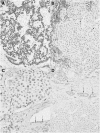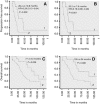O6-Methylguanine-DNA methyltransferase status in neuroendocrine tumours: prognostic relevance and association with response to alkylating agents
- PMID: 25584486
- PMCID: PMC4453664
- DOI: 10.1038/bjc.2014.660
O6-Methylguanine-DNA methyltransferase status in neuroendocrine tumours: prognostic relevance and association with response to alkylating agents
Abstract
Background: O(6)-Methylguanine-DNA methyltransferase (MGMT) loss of expression has been suggested to be predictive of response to temozolomide in neuroendocrine tumours (NETs), but so far, only limited data are available. We evaluated the prognostic and predictive value of MGMT status, assessed by two molecular methods and immunohistochemistry, in a large series of NETs of different origins.
Methods: A total of 107 patients, including 53 treated by alkylants (temozolomide, dacarbazine or streptozotocin), were retrospectively studied. In each case, we used methyl-specific PCR (MS-PCR) and pyrosequencing for evaluation of promoter methylation and immunohistochemistry for evaluation of protein status.
Results: MGMT promoter methylation was detected in 12 out of 99 (12%) interpretable cases by MS-PCR and in 24 out of 99 (24%) by pyrosequencing. O(6)-Methylguanine-DNA methyltransferase loss of expression was observed in 29 out of 89 (33%) interpretable cases. Status of MGMT was not correlated with overall survival (OS) from diagnosis. Progression-free survival and OS from first alkylant use (temozolomide, dacarbazine and streptozotocin) were higher in patients with MGMT protein loss (respectively, 20.2 vs 7.6 months, P<0.001 and 105 vs 34 months, P=0.006) or MGMT promoter methylation assessed by pyrosequencing (respectively, 26.4 vs 10.8 months, P=0.002 and 77 vs 43 months, P=0.026).
Conclusions: Our results suggest that MGMT status is associated with response to alkylant-based chemotherapy in NETs.
Figures



References
-
- Arnold CN, Sosnowski A, Schmitt-Graff A, Arnold R, Blum HE. Analysis of molecular pathways in sporadic neuroendocrine tumors of the gastro-entero-pancreatic system. Int J Cancer. 2007;120:2157–2164. - PubMed
-
- Auernhammer CJ, Goke B. Therapeutic strategies for advanced neuroendocrine carcinomas of jejunum/ileum and pancreatic origin. Gut. 2011;60:1009–1021. - PubMed
-
- Bajetta E, Ferrari L, Procopio G, Catena L, Ferrario E, Martinetti A, Di Bartolomeo M, Buzzoni R, Celio L, Vitali M, Beretta E, Seregni E, Bombardieri E. Efficacy of a chemotherapy combination for the treatment of metastatic neuroendocrine tumours. Ann Oncol. 2002;13:614–621. - PubMed
-
- Chan AO, Kim SG, Bedeir A, Issa JP, Hamilton SR, Rashid A. CpG island methylation in carcinoid and pancreatic endocrine tumors. Oncogene. 2003;22:924–934. - PubMed
Publication types
MeSH terms
Substances
LinkOut - more resources
Full Text Sources
Other Literature Sources
Medical
Research Materials

